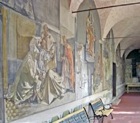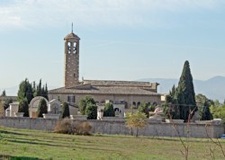
The church stands beside what was the eastern branch of Via Flaminia. The adjacent civic cemetery stands on the site the site of a Roman necropolis that was in use in the 1st - 3rd centuries AD.
Early Church on the Site ?
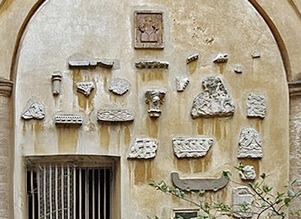
According to Guerrini and Latini (referenced below, pp. 281-3, entry 42), the architectural fragments embedded into the back wall of the cloister (see below) date to the 8th or 9th century. They constitute the only surviving evidence for a possible early church on the later site of Santa Maria in Campis.
It is interesting to note that this putative early church at Santa Maria in Campis predates any hypothesised for central Foligno, except perhaps for the presumed martyrium of St Felician of ca. 850. The latter is evidenced by far fewer architectural fragments from this period:
-
✴the middle column of the colonnade at the rear of the loggia of the minor facade; and
-
✴a cornice that was probably found during the restoration of the Duomo in 1903-4, which is now in the Museo Diocesano.
Present Church
The present church was referred to as:
-
✴Santa Maria de Fulginea in a bull of 1138, in which Pope Innocent II confirmed it as a possession of the Bishop Benedetto of Foligno; and
-
✴Santa Maria de Campis, in another document dated 1188. (‘Campis’ is the Latin word for a plain or level field).
The church was originally under episcopal authority, and acquired the status of a collegiata: by 1373, it had a prior and two canons.
In 1373, after a ceremony attended by the Trinci lords, the church and canonica passed to the quasi-Cistercian Congregation of Corpus Christi. This congregation, which had been initiated at Gualdo Tadino in 1328 under the auspices of Bishop Andrea Vincioli of Nocera Umbra, had a particular veneration for the Eucharistic blood of Christ. A small group of mostly Umbrian monasteries joined the congregation, but it did not receive papal approval until 1393.
In fact, Pope Boniface IX gave his approval after a visit to Santa Maria in Campis in 1392. He had heard about a venerated image of the Madonna and Child here (see below) and wished to see it. The visit obviously went well because he not only confirmed papal recognition of the congregation but also moved its headquarters to Santa Maria in Campis and granted indulgences for those visiting the church. For a period thereafter, the church became known as Santa Maria Maggiore. At the same time, he placed it under the jurisdiction of the Cistercian Abbazia di San Salvatore di Monte Acuto, Umbertide. The cohesion of the group was not particularly strong and two of the monasteries, Santa Maria in Campis and San Fiorenzo, Perugia, transferred to the jurisdiction of the Cistercian Abbazia di San Galgano in 1395.
In 1404, the monks of Santa Maria in Campis assumed responsibility for the nuns of Santa Maria di Betlem, whose nunnery was next to a small church and hospice that they owned in the city.
In 1582, Pope Gregory XIII transferred Santa Maria in Campis to the Olivetan order, and the Congregation of Corpus Christi came to an end. In 1672, the monks gave their church and hospice in the city to the nuns of the adjacent Santa Maria di Betlem so that they could use the site for their new church.
The Olivetans remained at Santa Maria in Campis until 1818 and returned in 1903. In 1983, the complex passed to the Observant Franciscans and in 2001 to the Vocationist Fathers.
Exterior
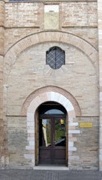

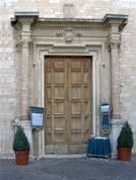
The central part of the facade belongs to the original nucleus, corresponding to the barrel-vaulted nave within.
-
✴The arms of Boniface IX above the side entrance record his visit to Foligno in 1392. The finance for the construction of the left aisle of the church presumably followed his granting of indulgences during that visit.
-
✴The right aisle was added at an unknown date.
-
✴The date 1669 is inscribed at the base of the left-hand column of the central portal.
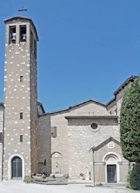
Interior
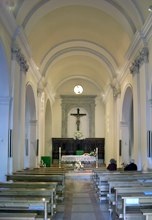
The church has suffered over time, not least in the earthquake of 1832. The unsympathetic rebuilding of the apse and campanile in 1849-50 caused further damage, as did other modifications made to the chapels in the left aisle (see below). A restoration in the 1950s recovered as much as possible of the original interior.
The church was originally in the form of a Latin cross, with a single nave. As mentioned above, the aisles were later additions. The apse, the left transept and the left apsidal chapels were destroyed in the earthquake of 1832: the present apse, which was rebuilt in 1849, is much more shallow than the original one.
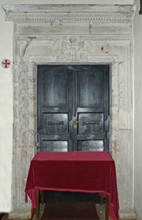
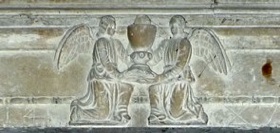
The portal at the end of the right aisle has the arms of the Congregation of Corpus Christi and the date 1487.
Left Aisle
Water stoup (1649)
The marble water stoup to the right of the side entrance has its date inscribed at the base.
Frescoes
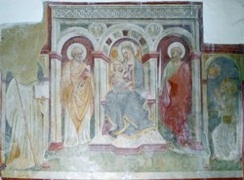
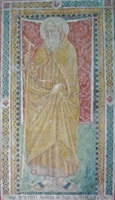
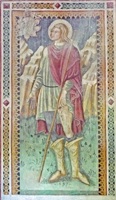
The frescoes that have been recovered here include:
-
✴the Madonna and Child with SS Peter and Paul (15th century), with smaller figures of St Bernard (the founder of the Cistercians) and the Blesses Peter Crisci to the sides;
-
✴St Antony Abbot (1483), which has the date and the name of the donor, Nonfro di Paolo inscribed along the bottom; and
-
✴St Roch (1497), which is dated by inscription (on the pilaster between the entrances to the 1st chapel).
Cappella della Navicella
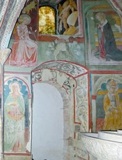
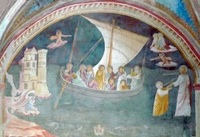
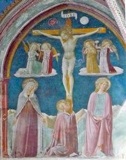
The merchant di Pietro di Cola della Casse commissioned this chapel (the 1st on the left), in 1452. The frescoes (1454-60), which are usually attributed at least in part to Pierantonio Mezzastris include:
-
✴the Annunciation and SS Lucy and Helen on the left wall;
-
✴the Navicella (or Christ walking on the water) on the back wall, which was based on Giotto’s celebrated fresco (ca. 1310) in the atrium of old St Peter’s, Rome; and
-
✴the Crucifixion with the Virgin and SS John the Evangelist and Mary Magdalene on the right wall.
Second Chapel
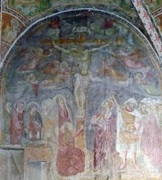
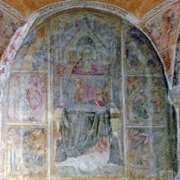
The frescoes (15th century) in this chapel, which are attributed to Giovanni di Corraduccio Mazzaforte, depict:
-
✴the Crucifixion with the Virgin and her ladies and SS John the Evangelist and Mary Magdalene, on the right wall;
-
✴the Madonna and Child with St Stephen, on the back wall (not illustrated here); and
-
✴St Antony Abbot and scenes from his life, on the left wall.
Left Transept
The organ was installed on the back wall in the 19th century.

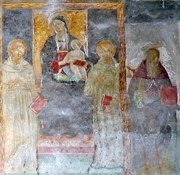
Ciborium (15th century)
This marble ciborium on the left wall was recomposed from fragments in the early 20th century.
Madonna and Child with saints (1507)
This fresco to the right of the ciborium, which is dated by inscription, is sometimes attributed to Ugolino di Gisberto. It depicts the Madonna and Child with SS Francis and Antony of Padua, with a figure of St Antony Abbot to the right. Another figure further to the right, which apparently depicted St Joseph, has been lost.
Cappella di Santa Marta
Bishop Paolo Trinci built this chapel (the outer apsidal chapel on the left) in 1330 at the base of the campanile. He also endowed it with considerable property, presumably to finance Masses to be said for his soul. Trincia and Corrado Trinci renovated it in 1373. The chapel was closed in the 17th century and subsequently forgotten until the frescoes were rediscovered in 1901. The campanile was finally demolished in 1949 to facilitate the restoration of the chapel and its frescoes.
Frescoes (1456-8)
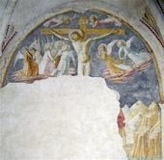
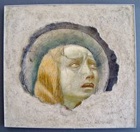
According to the historian Ludovico Jacobili, the fresco of the Crucifixionn on the back wall of this chapel was signed by Nicolò di Liberatore, l’ Alunno and dated 1458: any such signature has since disappeared but the attribution is confirmed on stylistic grounds. It was damaged when a door was inserted here in 1515. A fragment of the head of St John the Evangelist,which came from this fresco, is now in the Museo Diocesano.
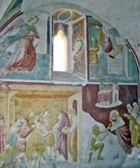
-
✴the Annunciation and two scenes from the life of St Thomas on the left wall (illustrated here);
-
✴other scenes from the life of St Thomas on the right wall; and
-
✴standing figures of the Madonna and Child and SS Catherine, Lucy and Benedict in the entrance arch.
Cappella del SS Sacramento
This chapel is to the right of the Cappella di Santa Marta.
Frescoes (15th century)
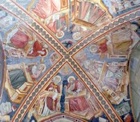
-
✴the Last Supper, on the left; and
-
✴a fragmentary Ascension of Christ, on the right.
Right Wall
Frescoes (mostly 5th century)
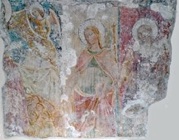
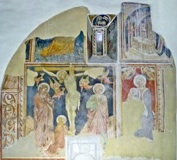
These depict (starting at the end furthest from the entrance):
-
✴a fragment of the Crucifixion (14th century), above the entrance to the sacristy (not illustrated);
-
✴three adjacent figures that survive from a larger work, which depict:
-
•part of a Madonna della Misercordia, with singing monks to the right;
-
•St Catherine of Alexandria; and
-
•St Roch; and
-
✴frescoes in a lunette that depict:
-
•fragments of an Annunciation, to the sides of the window, and the Lamb of God above it;
-
•the Crucifixion with the Virgin and SS John the Evangelist and Mary Magdalene; and
-
•the Madonna and Child enthroned.
Monument to Pietro Lodam (died 1449)
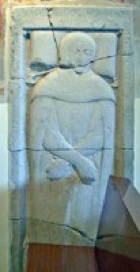
Sacristy
The door on the right furthest from the counter-facade leads to the sacristy.
Madonna and Child (14th century)
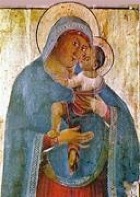
Cloister
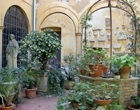
-
✴The arms of the Congregation of Corpus Christi (two angels holding Eucharistic chalice) are on the architrave of the door.
-
✴The arms of the Olivetans (a cross above three hills), dated 1703, are on the back wall (illustrated below), among .
Scenes from the life of Blessed Bernardo Tolomei (1963)
